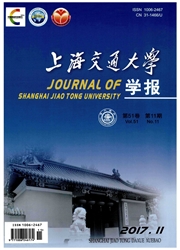

 中文摘要:
中文摘要:
为了揭示双叶片离心泵内失速现象的发生和发展过程,采用三维粒子图像测速(PIV)系统对比转数为134的双叶片离心泵在4个工况下3个截面的流体流动进行了分析.结果表明:随着流体流量的减小,叶片的压力面首先出现流动分离并产生漩涡;当流体流量继续减小时,漩涡堵塞了流道而使流体流动受阻,造成了叶轮流道失速的现象.在最优工况下,叶轮内流体的流态最佳;在0.8倍最优工况下,中间截面发生了流动分离;在0.5倍最优工况下,中间截面的流动分离扩张并产生了失速;在流量减小至0.2倍最优工况的流量之前,前盖板处也出现了失速,而在后盖板处没有发现漩涡.同时,叶轮内流场的轴向速度很不均匀,由流道进口到出口、吸力面到压力面,其轴向速度逐渐减小,并且叶片压力面的负向轴向速度区域随着失速的发展而扩大.
 英文摘要:
英文摘要:
In order to study the stall in centrifugal pumps, the internal flow field in three sections of a double-blade centrifugal pump was measured by 3D particle image velocimetry technique (PIV) at four flow rates. With the decrease of the flow rate, flow separation occurs at the pressure side of the impeller blade firstly, which results in a vortex near the pressure side of the blade. When the flow decreases more, the vortex blocks the channel and flow field gets worse, which causes the stall phenomenon. Under the optimum condition, the flow pattern in the impeller is best. At 0.8Qopt(the flow rate at the optimum condition), flow separation is observed in the middle section. At 0.5Qopt, the stall occurs in the middle section due to the extending of flow separation. Before reducing the flow rate to 0.2Qopt, the stall occurs in the section near the shroud. But there is no vortex found in the section near the hub. The axial velocity field in the passage shows an asymmetrical distribution, and the axial velocity decreases from the entrance to the exit of the passage. Also, it decreases from suction side to pressure side of the blade. And the negative axial velocity area near the pressure surface extends with the development of stall.
 同期刊论文项目
同期刊论文项目
 同项目期刊论文
同项目期刊论文
 Multi-condition optimization and experimental measurements of a double-blade centrifugal pump impell
Multi-condition optimization and experimental measurements of a double-blade centrifugal pump impell Application of different strategies of partitioned fluid-structure interaction simulation for a sing
Application of different strategies of partitioned fluid-structure interaction simulation for a sing Investigation of unsteady flow-induced impeller oscillations of a single-blade pump under off-design
Investigation of unsteady flow-induced impeller oscillations of a single-blade pump under off-design Numerical Prediction of Unsteady Pressure Field Within the Whole Flow Passage of a Radial Single-Bla
Numerical Prediction of Unsteady Pressure Field Within the Whole Flow Passage of a Radial Single-Bla 期刊信息
期刊信息
